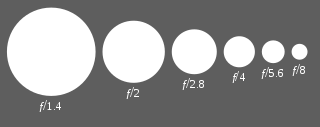
Back F-nommer Afrikaans عدد البؤرة Arabic Лік дыяфрагмы BE-X-OLD Относителна апертура Bulgarian এফ-নাম্বার Bengali/Bangla Nombre f Catalan Clonové číslo Czech Blendenzahl German Αριθμός διαφράγματος ανοίγματος Greek F-number English

Dalam optika, bukaan atau nilai bukaan (bahasa Inggris: f-number, focal ratio, relative aperture)[1] adalah bilangan yang menunjukkan korelasi jarak pumpun lensa terhadap tingkapan. Sebagai contoh, lensa dengan jarak pumpun 100mm, pada pengaturan bukaan 4 (nilai tingkapan f/4), mempunyai arti bahwa diafragma pada lensa tersebut sedang terbuka dengan diameter 25mm. Biasanya dilambangkan dengan huruf "f". Nilai bukaan umumnya merupakan urutan 1, 1.2, 1.4, 2, 2.8, 4, 5.6, 8, 11, 16, dan seterusnya. Karena bukaan adalah perbandingan antara jarak pumpun lensa dengan diameter dari diafragma yang terbuka saat itu, maka untuk satu nilai bukaan (misalnya 8) pada semua lensa (tidak tergantung dari jarak pumpun lensa tersebut), akan meneruskan intensitas cahaya yang sama.
Pada tahun 1867, Thomas Sutton dan George Dawson mendefinisikan nisbah tingkapan (apertal ratio) yang pada dasarnya setara dengan nilai bukaan (f-number):[2]
In every lens there is, corresponding to a given apertal ratio (that is, the ratio of the diameter of the stop to the focal length), a certain distance of a near object from it, between which and infinity all objects are in equally good focus. For instance, in a single view lens of 6 inch focus, with a 1/4 in. stop (apertal ratio one-twenty-fourth), all objects situated at distances lying between 20 feet from the lens and an infinite distance from it (a fixed star, for instance) are in equally good focus. Twenty feet is therefore called the 'focal range' of the lens when this stop is used. The focal range is consequently the distance of the nearest object, which will be in good focus when the ground glass is adjusted for an extremely distant object. In the same lens, the focal range will depend upon the size of the diaphragm used, while in different lenses having the same apertal ratio the focal ranges will be greater as the focal length of the lens is increased. The terms 'apertal ratio' and 'focal range' have not come into general use, but it is very desirable that they should, in order to prevent ambiguity and circumlocution when treating of the properties of photographic lenses.
Pada 1874, John Henry Dallmeyer menyebut nisbah sebagai intensity ratio sebuah lensa:[3]
The rapidity of a lens depends upon the relation or ratio of the aperture to the equivalent focus. To ascertain this, divide the equivalent focus by the diameter of the actual working aperture of the lens in question; and note down the quotient as the denominator with 1, or unity, for the numerator. Thus to find the ratio of a lens of 2 inches diameter and 6 inches focus, divide the focus by the aperture, or 6 divided by 2 equals 3; i.e., 1/3 is the intensity ratio.
Walaupun dia belum mengetahui teori Ernst Abbe mengenai stop dan pupil,[4] yang dipopulerkan oleh Siegfried Czapski pada tahun 1893,[5] Dallmeyer menyadari bahwa tingkap tidaklah sama dengan diameter sebuah aperture-stop.[3]
It must be observed, however, that in order to find the real intensity ratio, the diameter of the actual working aperture must be ascertained. This is easily accomplished in the case of single lenses, or for double combination lenses used with the full opening, these merely requiring the application of a pair of compasses or rule; but when double or triple-combination lenses are used, with stops inserted between the combinations, it is somewhat more troublesome; for it is obvious that in this case the diameter of the stop employed is not the measure of the actual pencil of light transmitted by the front combination. To ascertain this, focus for a distant object, remove the focusing screen and replace it by the collodion slide, having previously inserted a piece of cardboard in place of the prepared plate. Make a small round hole in the centre of the cardboard with a piercer, and now remove to a darkened room; apply a candle close to the hole, and observe the illuminated patch visible upon the front combination; the diameter of this circle, carefully measured, is the actual working aperture of the lens in question for the particular stop employed.
Anak dari John Henry Dallmeyer, Thomas Rudolphus Dallmeyer, seorang penemu lensa tele, mengikuti terminologi intensity ratio pada tahun 1899.[6]
- ^ Smith, Warren Modern Lens Design 2005 McGraw-Hill
- ^ Thomas Sutton and George Dawson, A Dictionary of Photography, London: Sampson Low, Son & Marston, 1867, (p. 122).
- ^ a b John Henry Dallmeyer, Photographic Lenses: On Their Choice and Use—Special Edition Edited for American Photographers, pamphlet, 1874.
- ^ Theory of stops
- ^ Siegfried Czapski, Theorie der optischen Instrumente, nach Abbe, Breslau: Trewendt, 1893.
- ^ Thomas R. Dallmeyer, Telephotography: An elementary treatise on the construction and application of the telephotographic lens, London: Heinemann, 1899.
